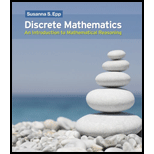
Discrete Mathematics: Introduction to Mathematical Reasoning
1st Edition
ISBN: 9780495826170
Author: Susanna S. Epp
Publisher: Cengage Learning
expand_more
expand_more
format_list_bulleted
Question
Chapter 1.3, Problem 3ES
a.
To determine
To calculate: The solution of relation
b.
To determine
To calculate: The solution of
c.
To determine
To calculate: The solution domain and co-domain of
d.
To determine
To calculate: The arrow diagram for
Expert Solution & Answer
Want to see the full answer?
Check out a sample textbook solution
Students have asked these similar questions
Obtain the voltage across the capacitor for the following input: (a) 5Volts; (b) 3sin(t); (c) 2 cos(t). Use Laplace transform and Cramer's rule.
1
For communcation marks. In the questions answered above should have the criteria
show proper mathematical form
use proper symbols, notations, conventions, graph(s) where applicable
solution is neat, clear and easy to follow
If you write on the paper in online version you will be assigned 0 marks except graph.
Chapter 1 Solutions
Discrete Mathematics: Introduction to Mathematical Reasoning
Ch. 1.1 - Prob. 1ESCh. 1.1 - Prob. 2ESCh. 1.1 - Prob. 3ESCh. 1.1 - Prob. 4ESCh. 1.1 - Prob. 5ESCh. 1.1 - Prob. 6ESCh. 1.1 - Prob. 7ESCh. 1.1 - Prob. 8ESCh. 1.1 - Prob. 9ESCh. 1.1 - Prob. 10ES
Ch. 1.1 - Prob. 11ESCh. 1.1 - Prob. 12ESCh. 1.1 - Prob. 13ESCh. 1.2 - Prob. 1ESCh. 1.2 - Prob. 2ESCh. 1.2 - Prob. 3ESCh. 1.2 - Prob. 4ESCh. 1.2 - Prob. 5ESCh. 1.2 - Prob. 6ESCh. 1.2 - Prob. 7ESCh. 1.2 - Prob. 8ESCh. 1.2 - Prob. 9ESCh. 1.2 - Prob. 10ESCh. 1.2 - Prob. 11ESCh. 1.2 - Prob. 12ESCh. 1.3 - Prob. 1ESCh. 1.3 - Prob. 2ESCh. 1.3 - Prob. 3ESCh. 1.3 - Prob. 4ESCh. 1.3 - Prob. 5ESCh. 1.3 - Prob. 6ESCh. 1.3 - Prob. 7ESCh. 1.3 - Prob. 8ESCh. 1.3 - Prob. 9ESCh. 1.3 - Prob. 10ESCh. 1.3 - Prob. 11ESCh. 1.3 - Prob. 12ESCh. 1.3 - Prob. 13ESCh. 1.3 - Prob. 14ESCh. 1.3 - Prob. 15ESCh. 1.3 - Prob. 16ESCh. 1.3 - Prob. 17ESCh. 1.3 - Prob. 18ESCh. 1.3 - Prob. 19ESCh. 1.3 - Prob. 20ES
Knowledge Booster
Learn more about
Need a deep-dive on the concept behind this application? Look no further. Learn more about this topic, subject and related others by exploring similar questions and additional content below.Similar questions
- a) If is a polynomial function, does always have to have a horizontal asymptote? If no, provide a counterexample. ax+b b) Write an equation for a rational function whose graph of the formex+d where f(x) has all the indicated features. X-intercept of 14 Y-intercept of -1/2 VA with equation -2/3 HA with equation 4/3arrow_forwardPlease find the open intervals where the functions are concave upward or concave downward. Find any inflection points also thanks!Note: This is a practice problem!arrow_forwardAn airplane has a speed of 400 km/h with no wind. The airplane flies 2140 km with the wind. The airplane can only fly 1860 km against the wind in the same time. If w represents the speed of the wind, create an equation could be used to solve for w? Find the speed f the wind. hint; Use Time = Distance / speedarrow_forward
- x²+8x+15 f(x) = Consider the function. x²-x-12 a) Determine the following key features of the function: i) domain and range ii) intercepts iii) equations of any asymptotes and holes iv) intervals where the function is increasing and intervals where the function is decreasing v) Sketch the graph.arrow_forwardPls help ASAParrow_forwardPls help ASAParrow_forward
- Pls help ASAParrow_forwardUse the graph below to evaluate each limit. -11 -10 -9 -8 -6 -5 -- + -0.3 -3 -2 -0.2 -0.1- ▼ 0 1 2 -0.1- -0.2- -0.3- 3. 4 5 -0 6 -0:4 -edit-graph-on- desmos lim f(x)= _9-←x lim f(x)⇒ x→1 ☐☐ lim f(x)⇒ +9-←x lim f(x)⇒ x→−4+ lim f(x)⇒ x→1+ lim f(x)= x→2+ lim f(x)⇒ x→-4 lim f(x)⇒ x→2arrow_forwardPlease help me with this question on statisticsarrow_forward
- Please help me with this statistics questionarrow_forwardPlease help me with the following statistics questionFor question (e), the options are:Assuming that the null hypothesis is (false/true), the probability of (other populations of 150/other samples of 150/equal to/more data/greater than) will result in (stronger evidence against the null hypothesis than the current data/stronger evidence in support of the null hypothesis than the current data/rejecting the null hypothesis/failing to reject the null hypothesis) is __.arrow_forwardPlease help me with the following question on statisticsFor question (e), the drop down options are: (From this data/The census/From this population of data), one can infer that the mean/average octane rating is (less than/equal to/greater than) __. (use one decimal in your answer).arrow_forward
arrow_back_ios
SEE MORE QUESTIONS
arrow_forward_ios
Recommended textbooks for you
- Algebra & Trigonometry with Analytic GeometryAlgebraISBN:9781133382119Author:SwokowskiPublisher:Cengage
 Algebra for College StudentsAlgebraISBN:9781285195780Author:Jerome E. Kaufmann, Karen L. SchwittersPublisher:Cengage Learning
Algebra for College StudentsAlgebraISBN:9781285195780Author:Jerome E. Kaufmann, Karen L. SchwittersPublisher:Cengage Learning
 Elements Of Modern AlgebraAlgebraISBN:9781285463230Author:Gilbert, Linda, JimmiePublisher:Cengage Learning,
Elements Of Modern AlgebraAlgebraISBN:9781285463230Author:Gilbert, Linda, JimmiePublisher:Cengage Learning, Elementary Linear Algebra (MindTap Course List)AlgebraISBN:9781305658004Author:Ron LarsonPublisher:Cengage Learning
Elementary Linear Algebra (MindTap Course List)AlgebraISBN:9781305658004Author:Ron LarsonPublisher:Cengage Learning Big Ideas Math A Bridge To Success Algebra 1: Stu...AlgebraISBN:9781680331141Author:HOUGHTON MIFFLIN HARCOURTPublisher:Houghton Mifflin Harcourt
Big Ideas Math A Bridge To Success Algebra 1: Stu...AlgebraISBN:9781680331141Author:HOUGHTON MIFFLIN HARCOURTPublisher:Houghton Mifflin Harcourt

Algebra & Trigonometry with Analytic Geometry
Algebra
ISBN:9781133382119
Author:Swokowski
Publisher:Cengage

Algebra for College Students
Algebra
ISBN:9781285195780
Author:Jerome E. Kaufmann, Karen L. Schwitters
Publisher:Cengage Learning


Elements Of Modern Algebra
Algebra
ISBN:9781285463230
Author:Gilbert, Linda, Jimmie
Publisher:Cengage Learning,

Elementary Linear Algebra (MindTap Course List)
Algebra
ISBN:9781305658004
Author:Ron Larson
Publisher:Cengage Learning

Big Ideas Math A Bridge To Success Algebra 1: Stu...
Algebra
ISBN:9781680331141
Author:HOUGHTON MIFFLIN HARCOURT
Publisher:Houghton Mifflin Harcourt
What is a Relation? | Don't Memorise; Author: Don't Memorise;https://www.youtube.com/watch?v=hV1_wvsdJCE;License: Standard YouTube License, CC-BY
RELATIONS-DOMAIN, RANGE AND CO-DOMAIN (RELATIONS AND FUNCTIONS CBSE/ ISC MATHS); Author: Neha Agrawal Mathematically Inclined;https://www.youtube.com/watch?v=u4IQh46VoU4;License: Standard YouTube License, CC-BY